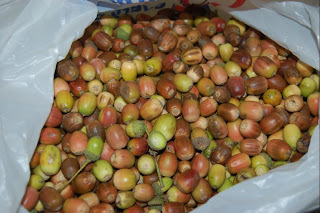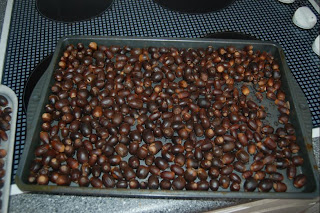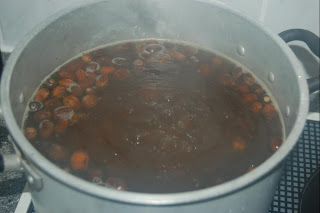We grow our own food in a suburban village in the North East of England. Follow us as we keep up the battle to be self-sufficient.
Sunday 30 November 2008
Plucking pheasants - easier that I expected!
Thursday 27 November 2008
Pheasants
News has just arrived. David has traded some jars of jam for a couple of pheasants. So this weekend we will be plucking pheasants! There has to be a first for everything.
---
Sent via BlackBerry
---
Sent via BlackBerry
Monday 24 November 2008
Blackberry whisky pie
I have to confess the pie was on the strong side! I took it to work for colleagues to try. It was all gone in 15 minutes. Apparently three spoonfuls put you over the limit!
Sunday 23 November 2008
Digging over
We have done some work to dig over the allotment and get it ready for next year, though there is still plenty to do. We have also set up a new compost bin. The constant weeding throughout the summer ended up with a number of small compost heaps throughout the allotment. So be build a large frame from old logs and consolidated all the small heaps into it. We also added 3 sacks of shredded papers from the house. My shredded bank statements will be rotted down and added to the land. At last I'm getting some value from them!
 The above shot is of the most productive part of the allotment so far. We grew the onions, beans and courgettes here. You can also see the chard continuing to grow. David has planted some garlic here.
The above shot is of the most productive part of the allotment so far. We grew the onions, beans and courgettes here. You can also see the chard continuing to grow. David has planted some garlic here.
 Above is the bottom end of the allotment. It needs a bit more work doing on it but now has an apple tree and a plum tree. There is a large strawberry patch here. We also grow some herbs on this patch.
Above is the bottom end of the allotment. It needs a bit more work doing on it but now has an apple tree and a plum tree. There is a large strawberry patch here. We also grow some herbs on this patch.
 This patch was dug over in March but not used. It needs digging over again and the weeds removing. It will then need to be well composted. I want this for growing spuds next year.
This patch was dug over in March but not used. It needs digging over again and the weeds removing. It will then need to be well composted. I want this for growing spuds next year.
 The above bed was the scene of our disaster crops. We got come cauliflowers from this area but the potatoe crop was a failure. It has however been composted but I am thinking about putting a pond here to store rain water which will run off the greenhouse when we build it. We will install water butts but the pond can act as additional storage. As it is, the ground here is already wet. I also want the pond to encourage more frogs onto the allotment. We have some already so someone must have a pond in the vacinity where they spawn. The frogs will be good for keeping down the bugs.
The above bed was the scene of our disaster crops. We got come cauliflowers from this area but the potatoe crop was a failure. It has however been composted but I am thinking about putting a pond here to store rain water which will run off the greenhouse when we build it. We will install water butts but the pond can act as additional storage. As it is, the ground here is already wet. I also want the pond to encourage more frogs onto the allotment. We have some already so someone must have a pond in the vacinity where they spawn. The frogs will be good for keeping down the bugs.
Raspberry gin and cherry vodka
I got round this evening to bottling the rapsberry gin and cherry vodka we set away in the summer. I sampled both and was pleased with the results. My favourite was the raspberry gin.
We are leaving the sloe gin for a while longer. It was made from fruit that was picked last year then frozen. The colour doesn't look right. It may be that this one has failed. We shall see.
The fruit will be used for deserts.
Another home grown meal
Shepherds pie, all the contents grown at home except for the mince! That came off a supermarket shelf. But the potatoes, onion and garlic were all grown on either our allotment or Dad's. We had it with broad beans, one of our most successful crops.
---
Sent via BlackBerry
Sunday 16 November 2008
Acorn flour
In our move towards self-sufficiency, finding a substitute for commercially produced flour is important. Since we are unlikely to be able to grow our own wheat, our source of flour has to be both wild and abundant. Years ago I read about using acorns to make flour, so I got out the old wild foods cookbooks and read all about it.
Generally, cookbooks tended to suggest acorn flour was not worth the effort, making acorns edible was just too time and energy consuming. Having now tried out acorns for making flour, I must say I disagree. I ended up using less time and energy than I anticipated. Anyway, the following is what I did. It being autumn, acorns are in abundance (unlike hazel nuts! - see some of my previous posts). They are remarkably easy to gather. There is no climbing up trees or trying to reach out-of-reach branches. The forest floor is where you look for them. And under oak trees, you will find the ground carpetted with acorns. Up here in the North East, the best time to get them is mid October, before the squirrels take the lot and the weather turns them into something unusable. I got a carrier bag full in less than an hour.
It being autumn, acorns are in abundance (unlike hazel nuts! - see some of my previous posts). They are remarkably easy to gather. There is no climbing up trees or trying to reach out-of-reach branches. The forest floor is where you look for them. And under oak trees, you will find the ground carpetted with acorns. Up here in the North East, the best time to get them is mid October, before the squirrels take the lot and the weather turns them into something unusable. I got a carrier bag full in less than an hour.
 Once roasted, they need to be soaked. Since we were still experimenting, we divided our batch into two. The smaller batch was shelled and then steeped in water. Every day for the next 4 days, the water was changed. The aim was to leech out the tanin and yes, it did seem to work. The water turned a pale brown colour. After 4 days I tried one of the acorns and there was no bitter taste. This surprised me as the recipe books talked of having to do this process for two weeks.
Once roasted, they need to be soaked. Since we were still experimenting, we divided our batch into two. The smaller batch was shelled and then steeped in water. Every day for the next 4 days, the water was changed. The aim was to leech out the tanin and yes, it did seem to work. The water turned a pale brown colour. After 4 days I tried one of the acorns and there was no bitter taste. This surprised me as the recipe books talked of having to do this process for two weeks.
 The other, larger batch was steeped unshelled and as with the shelled batch, the water was changed every day for four days. Much less tanin seemed to leech out, judging by the colour of the water. We decided after 4 days to try boiling them. We boiled them for about three hours, changing the water twice. As you can see from the photo, the water quickly turns to a dark brown colour, giving it almost the appearance of tea.
The other, larger batch was steeped unshelled and as with the shelled batch, the water was changed every day for four days. Much less tanin seemed to leech out, judging by the colour of the water. We decided after 4 days to try boiling them. We boiled them for about three hours, changing the water twice. As you can see from the photo, the water quickly turns to a dark brown colour, giving it almost the appearance of tea.
 After the boiling process, they were shelled. This is the most time consuming part so I sat down with them and watched a 3 hour film (Schindler's List - one of my favourites) whilst ripping the shells from them. (Don't try this at home if you bite your fingernails!) At this point, the acorns look a bit like coffee beans.
After the boiling process, they were shelled. This is the most time consuming part so I sat down with them and watched a 3 hour film (Schindler's List - one of my favourites) whilst ripping the shells from them. (Don't try this at home if you bite your fingernails!) At this point, the acorns look a bit like coffee beans.
The shelled acorns then need to be dried. We did this by putting them in the oven on baking trains at a low heat (60C) for a couple of hours.

Once they had gone through the drying process, they need to be ground. We put ours through the food blender. I guess that if we had left the acorns in the blender for much longer, we would have got a finer flour. What we got wasn't a super fine powdery flour, but it was good enough.
Generally, cookbooks tended to suggest acorn flour was not worth the effort, making acorns edible was just too time and energy consuming. Having now tried out acorns for making flour, I must say I disagree. I ended up using less time and energy than I anticipated. Anyway, the following is what I did.
Unlike hazel and beech nuts, acorns cannot be eaten raw. They are full of tanin and therefore very bitter. You could try to eat them raw but you would probably feel horrible sick. So you have to go through a process of roasting and soaking the acorns to get rid of the tanin.
Spread the acorns on baking trays and put them in the oven for about 5 hours at the lowest heat. I roasted them at 60C.
The shelled acorns then need to be dried. We did this by putting them in the oven on baking trains at a low heat (60C) for a couple of hours.
Once they had gone through the drying process, they need to be ground. We put ours through the food blender. I guess that if we had left the acorns in the blender for much longer, we would have got a finer flour. What we got wasn't a super fine powdery flour, but it was good enough.
One final point. I notice a bit of condensation in the container so the flour is still not entirely dried out. So storage will have to be in the fridge and it won't last too long so we will need to use it up reasonably quickly.
My thoughts on making acorn flour are that: 1) it is easier than the cookbooks said; 2) the bitter taste is got rid of much more easily than the cookbooks said; 3) next time, I think we should avoid the initial roasting, boil the lot and then follow the drying process from there.
So, all we have to do now is bake with the flour. But that is for another post.
Chard
For anyone starting out on growing their own food, I recommend chard.
We have been picking the leaves fresh and steaming or boiling them (they're lovely with a bit of melted butter though given my own environmental guidelines, we keep the butter to a minimum). When leaves are picked, new ones grow in their place.
We are experimenting to see how long the chard will continue to grow. We have already had one frost and it is still going strong. We may freeze some of it soon.
Friday 14 November 2008
Parsnips
Roasted parsnips are one of my favourite foods! And we also experimented with growing parsnips on the allotment. A couple of weeks ago we had our first frosts so we have now dug up our crop. We are pleased with what we have though next year I hope to grow a much bigger crop.
I'm in the top picture holding a few of our prized possessions and David is in the second photo extracting the parsnips from the ground.
Blackberry whisky bottled
About three months ago, I used a batch of blackberries to make blackberry whisky. I had two preserving jars and by accident one had about two thirds more blackberries that the other.
Anyway, last night I set about bottling the whisky. I was surprised that there was considerably more liquid than could be contained in the two bottles the original whisky came in (Sainsbury's cheapest brand). I had to use an additional empty rum bottle. The first learning point is that the process seems to extract a large amount of juice from the fruit, far more than I expected.
The whisky itself was a lovely dark red colour, so the colour of the fruit had transferred well. I had a small sample from each preserving jar and really, you have to decide for yourself which was best. The one with less fruit did have a distinctive whisky taste and was my favourite, but both had worked.
So second learning point is to be a bit more balanced with the quantity of fruit added.
The whisky pickled blackberries themselves will be used next week in some home cooking.
Meanwhile, we have raspberry gin, sloe gin and cherry vodka ready to bottle up as well.
---
Sent via BlackBerry
Anyway, last night I set about bottling the whisky. I was surprised that there was considerably more liquid than could be contained in the two bottles the original whisky came in (Sainsbury's cheapest brand). I had to use an additional empty rum bottle. The first learning point is that the process seems to extract a large amount of juice from the fruit, far more than I expected.
The whisky itself was a lovely dark red colour, so the colour of the fruit had transferred well. I had a small sample from each preserving jar and really, you have to decide for yourself which was best. The one with less fruit did have a distinctive whisky taste and was my favourite, but both had worked.
So second learning point is to be a bit more balanced with the quantity of fruit added.
The whisky pickled blackberries themselves will be used next week in some home cooking.
Meanwhile, we have raspberry gin, sloe gin and cherry vodka ready to bottle up as well.
---
Sent via BlackBerry
Subscribe to:
Posts (Atom)